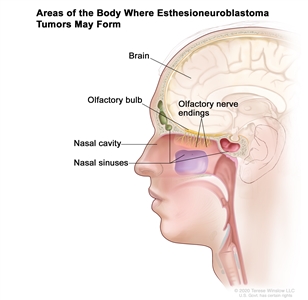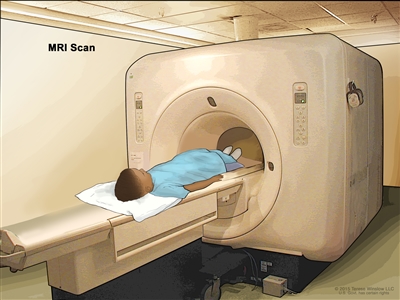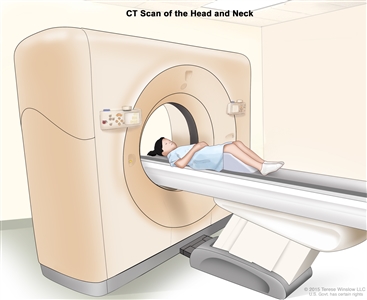Types of treatment for childhood esthesioneuroblastoma
Who treats children with esthesioneuroblastoma?
A pediatric oncologist, a doctor who specializes in treating children with cancer, oversees treatment of esthesioneuroblastoma. The pediatric oncologist works with other health care providers who are experts in treating children with cancer and who specialize in certain areas of medicine. Other specialists may include:
- pediatrician
- pediatric surgeon
- radiation oncologist
- pathologist
- pediatric nurse specialist
- social worker
- rehabilitation specialist
- psychologist
- child-life specialist
There are different types of treatment for children and adolescents with esthesioneuroblastoma. You and your child's care team will work together to decide treatment. Many factors will be considered, such as your child's overall health and whether the cancer is newly diagnosed or has come back.
Your child's treatment plan will include information about the cancer, the goals of treatment, treatment options, and the possible side effects. It will be helpful to talk with your child's care team before treatment begins about what to expect. For help every step of the way, see our downloadable booklet, Children with Cancer: A Guide for Parents.
Surgery
Surgery to remove the tumor is one of the main treatments for esthesioneuroblastoma.
After the doctor removes all the cancer that can be seen at the time of the surgery, your child may be given chemotherapy or radiation therapy to kill any cancer cells that are left. Treatment given after surgery to lower the risk that the cancer will come back is called adjuvant therapy.
Radiation therapy
Radiation therapy uses high-energy x-rays or other types of radiation to kill cancer cells or keep them from growing. Esthesioneuroblastoma may be treated with external beam radiation therapy. This type of radiation therapy uses a machine outside the body to send radiation toward the area of the body with cancer. Radiation therapy may be given alone or with other treatments, such as chemotherapy.
Learn more about External Beam Radiation Therapy for Cancer and Radiation Therapy Side Effects.
Chemotherapy
Chemotherapy (also called chemo) uses drugs to stop the growth of cancer cells. Chemotherapy either kills the cells or stops them from dividing. Chemotherapy may be given alone or with other types of treatment, such as radiation therapy.
For esthesioneuroblastoma, the chemotherapy is injected into a vein. When given this way, the drugs enter the bloodstream and can reach cancer cells throughout the body.
Chemotherapy drugs used alone or in combination to treat esthesioneuroblastoma in children include:
- cisplatin
- cyclophosphamide
- dactinomycin
- docetaxel
- doxorubicin
- etoposide
- ifosfamide
- irinotecan
- vincristine
Other chemotherapy drugs not listed here may also be used.
Learn more about Chemotherapy to Treat Cancer.
Clinical trials
For some children, joining a clinical trial may be an option. There are different types of clinical trials for childhood cancer. For example, a treatment trial tests new treatments or new ways of using current treatments. Supportive care and palliative care trials look at ways to improve quality of life, especially for those who have side effects from cancer and its treatment.
You can use the clinical trial search to find NCI-supported cancer clinical trials accepting participants. The search allows you to filter trials based on the type of cancer, your child's age, and where the trials are being done. Clinical trials supported by other organizations can be found on the ClinicalTrials.gov website.
Learn more about clinical trials, including how to find and join one, at Clinical Trials Information for Patients and Caregivers.
Treatment of childhood esthesioneuroblastoma
Treatment of newly diagnosed stage A esthesioneuroblastoma may include:
- surgery to remove the tumor followed by radiation therapy if visible tumor cells remain after surgery
Treatment of newly diagnosed stage B esthesioneuroblastoma may include:
- surgery to remove the tumor followed by radiation therapy
Treatment of newly diagnosed stage C esthesioneuroblastoma may include:
- chemotherapy followed by surgery to remove the tumor
- radiation therapy followed by surgery to remove the tumor
- chemotherapy and radiation therapy given at the same time followed by surgery to remove the tumor
Treatment of newly diagnosed stage D esthesioneuroblastoma may include:
- chemotherapy given before or after surgery to remove the tumor
- radiation therapy to the tumor and other places in the body where the cancer has spread
If the cancer comes back after treatment, your child's doctor will talk with you about what to expect and possible next steps. There might be treatment options that may shrink the cancer or control its growth. If there are no treatments, your child can receive care to control symptoms from cancer so they can be as comfortable as possible.
Use our clinical trial search to find NCI-supported cancer clinical trials that are accepting patients. You can search for trials based on the type of cancer, the age of the patient, and where the trials are being done. General information about clinical trials is also available.


